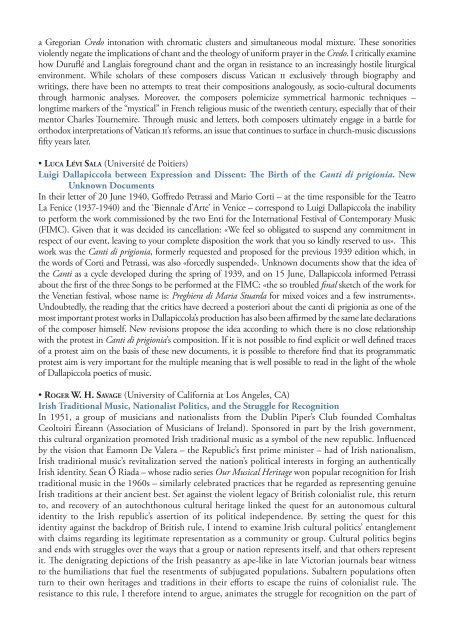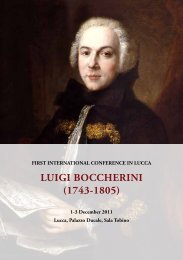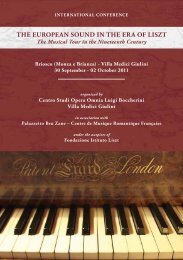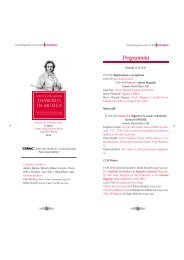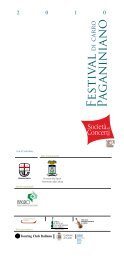PROGRAMME - Centro Studi Opera Omnia Luigi Boccherini
PROGRAMME - Centro Studi Opera Omnia Luigi Boccherini
PROGRAMME - Centro Studi Opera Omnia Luigi Boccherini
You also want an ePaper? Increase the reach of your titles
YUMPU automatically turns print PDFs into web optimized ePapers that Google loves.
a Gregorian Credo intonation with chromatic clusters and simultaneous modal mixture. These sonoritiesviolently negate the implications of chant and the theology of uniform prayer in the Credo. I critically examinehow Duruflé and Langlais foreground chant and the organ in resistance to an increasingly hostile liturgicalenvironment. While scholars of these composers discuss Vatican ii exclusively through biography andwritings, there have been no attempts to treat their compositions analogously, as socio-cultural documentsthrough harmonic analyses. Moreover, the composers polemicize symmetrical harmonic techniques –longtime markers of the “mystical” in French religious music of the twentieth century, especially that of theirmentor Charles Tournemire. Through music and letters, both composers ultimately engage in a battle fororthodox interpretations of Vatican ii’s reforms, an issue that continues to surface in church-music discussionsfifty years later.• Luca Lévi Sala (Université de Poitiers)<strong>Luigi</strong> Dallapiccola between Expression and Dissent: The Birth of the Canti di prigionia. NewUnknown DocumentsIn their letter of 20 June 1940, Goffredo Petrassi and Mario Corti – at the time responsible for the TeatroLa Fenice (1937-1940) and the ‘Biennale d’Arte’ in Venice – correspond to <strong>Luigi</strong> Dallapiccola the inabilityto perform the work commissioned by the two Enti for the International Festival of Contemporary Music(FIMC). Given that it was decided its cancellation: «We feel so obligated to suspend any commitment inrespect of our event, leaving to your complete disposition the work that you so kindly reserved to us». Thiswork was the Canti di prigionia, formerly requested and proposed for the previous 1939 edition which, inthe words of Corti and Petrassi, was also «forcedly suspended». Unknown documents show that the idea ofthe Canti as a cycle developed during the spring of 1939, and on 15 June, Dallapiccola informed Petrassiabout the first of the three Songs to be performed at the FIMC: «the so troubled final sketch of the work forthe Venetian festival, whose name is: Preghiera di Maria Stuarda for mixed voices and a few instruments».Undoubtedly, the reading that the critics have decreed a posteriori about the canti di prigionia as one of themost important protest works in Dallapiccola’s production has also been affirmed by the same late declarationsof the composer himself. New revisions propose the idea according to which there is no close relationshipwith the protest in Canti di prigionia’s composition. If it is not possible to find explicit or well defined tracesof a protest aim on the basis of these new documents, it is possible to therefore find that its programmaticprotest aim is very important for the multiple meaning that is well possible to read in the light of the wholeof Dallapiccola poetics of music.• Roger W. H. Savage (University of California at Los Angeles, CA)Irish Traditional Music, Nationalist Politics, and the Struggle for RecognitionIn 1951, a group of musicians and nationalists from the Dublin Piper’s Club founded ComhaltasCeoltoiri Éireann (Association of Musicians of Ireland). Sponsored in part by the Irish government,this cultural organization promoted Irish traditional music as a symbol of the new republic. Influencedby the vision that Eamonn De Valera – the Republic’s first prime minister – had of Irish nationalism,Irish traditional music’s revitalization served the nation’s political interests in forging an authenticallyIrish identity. Sean Ó Riada – whose radio series Our Musical Heritage won popular recognition for Irishtraditional music in the 1960s – similarly celebrated practices that he regarded as representing genuineIrish traditions at their ancient best. Set against the violent legacy of British colonialist rule, this returnto, and recovery of an autochthonous cultural heritage linked the quest for an autonomous culturalidentity to the Irish republic’s assertion of its political independence. By setting the quest for thisidentity against the backdrop of British rule, I intend to examine Irish cultural politics’ entanglementwith claims regarding its legitimate representation as a community or group. Cultural politics beginsand ends with struggles over the ways that a group or nation represents itself, and that others representit. The denigrating depictions of the Irish peasantry as ape-like in late Victorian journals bear witnessto the humiliations that fuel the resentments of subjugated populations. Subaltern populations oftenturn to their own heritages and traditions in their efforts to escape the ruins of colonialist rule. Theresistance to this rule, I therefore intend to argue, animates the struggle for recognition on the part of


